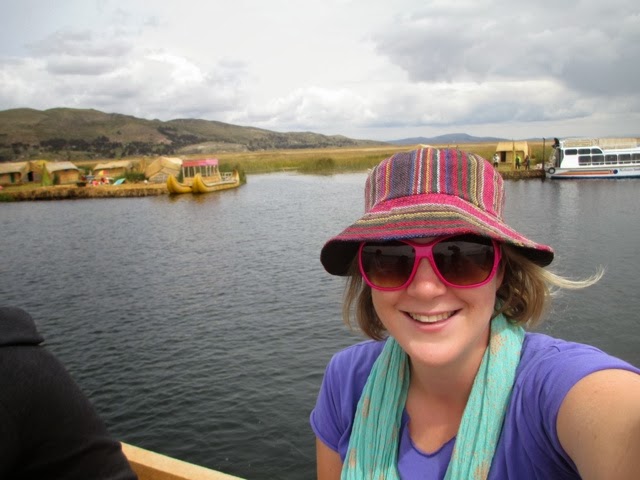From Cocacabana we headed over the Peruvian border to Puno to check out the Peruvian side of the lake.
The main draw for Peru is the floating islands - made of reed these show case a traditional lifestyle and are now a huge tourist attraction. Some people have mixed feelings - too touristy, but we quite enjoyed our experience!
So we had one night in Bothy hostel in Puno before heading off on a 2 day 1 night tour of the Peruvian islands (floating and normal). Although we booked with one of the tour agents that was recommended for being more socially responsible, we ended up on the same tour as everyone else in the hostel.
First we visited the reed islands with their distinctive reed huts and we were given a demonstration on how they create the islands.
We then got a reed boat to another island where you could get your passport stamped - so I did!
From the reed islands we headed to the second largest island on Lake Titicaca - Amantani. After 3 hours on our boat we were greeted by the locals that we would be sharing houses with and taken from the harbour up the hill to the villages.
Cat, I and Marie were staying with Norma. She is my age and has a 14 year old son - but her man ran off and is now shacked up with another woman. She lives with her son and her mother Julia. As we were a house of women we had much commiseration about the fact we were all single! I couldn't help but feel sorry for Norma - as the only one of 8 siblings to remain on the island with her mother she's unlikely to find another man and it's highly likely that Willam her son will leave the island.
We learnt that all school children learn Spanish, however Julia spoke Quechua as her first language and the whole family speak it at home. I learnt one word of Quechua - Inmanihya or hello! Norma's Spanish was very good - hence we got some insights into their lives and luckily so was Marie's so she could translate for us!
After having our lunch we headed to meet the rest of our group (we were split up into groups of 3/4 to spread the burden over several families - each family gets 30 soles per person to host and feed us). Our guide then took us on a short hike up to Pachatata - the brother hill to Pachamama (Mother Earth).
On the way he introduced us to several of the local plants - including potato crops, quinoa and the herb mounia, which we drank steeped as tea with our meals. This herb in particular is meant to be good for everything! Unsettled stomachs, coughs and altitude sickness is just a few things it's good for.
Ladies in their traditional dress - they all carried wool and embroidery with them and would multi task as they walked!
There wasn't anything really left of the temple so we enjoyed the sunset - not so spectacular that night and then hiked back before it was completely dark.
We managed to catch part of a volleyball game on the way back to Norma's
After dinner of quinoa soup followed by potato stew we were ready for bed - but no! Norma had other ideas and dressed us up in her finest for a party.
Musicians and local men in traditional dress - with the hats and ponchos we couldn't tell who was who!
That night was the loudest hail storm I've ever heard - the thunder shook the house and lots of hail was left the next morning. After a breakfast of yummy pancakes we headed to Taquile - our final island. Here the hail storm had done more damage - breaking some of the crops - despite the best efforts of the locals (shooting into the storm - probably not scientifically proven....
Distances to everywhere in the world! Not sure the directions are correct though (Paris and London are surely in the same direction from here?!)
The big thing on Taquile is the men knitting - often with 4 or 5 needles
The traditional dress is different on each of the islands. The hats the men knit on Taquile denote if the man is single or married or a head man in charge of the village.
Lunch was fresh lake trout and was delicious!
We just had to walk down 500 Inca steps back to the harbour to pick up our boat back to Puno
On the way back we saw the Uros islanders harvesting their reeds:













































































